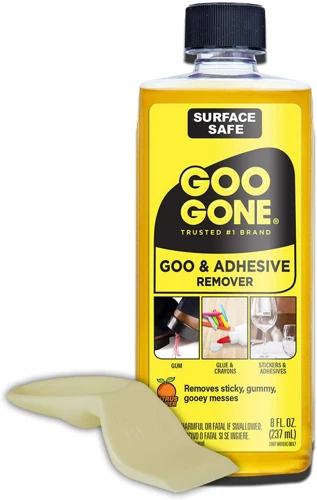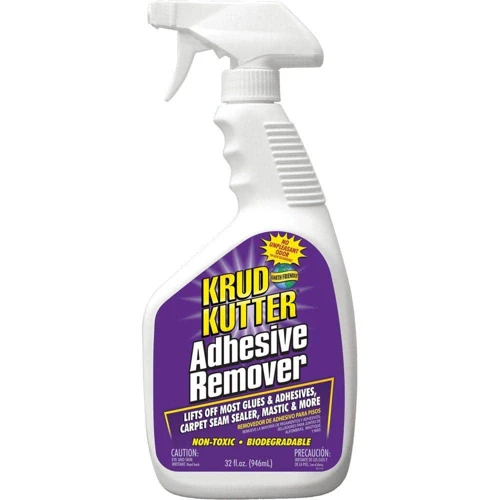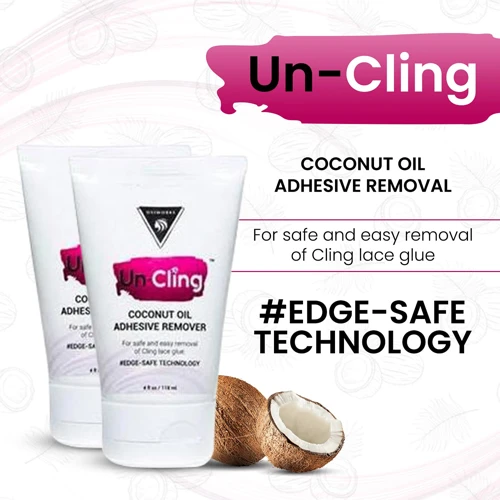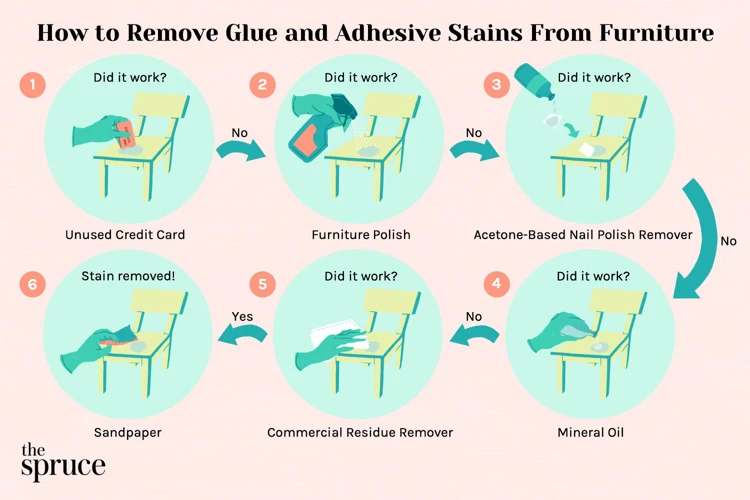Have you ever struggled to remove cling glue residue from a surface? It can be a frustrating and time-consuming process, especially if you don’t know the right techniques. Cling glue, also known as adhesive putty or sticky tack, is a versatile adhesive that is commonly used to hang posters, photos, and decorations. While it’s great for temporary use, the challenge comes when you need to remove it. In this comprehensive guide, we’ll explore the science behind cling glue, the surfaces and materials it affects, the tools and materials needed for removal, and several effective methods for removing cling glue step-by-step. By the end of this article, you’ll have the knowledge and tools needed to successfully remove cling glue from any surface without causing damage. So let’s get started!
Why is Removing Cling Glue Difficult?
Removing cling glue can be a real challenge, and many people find themselves struggling to get it off. The reason for this is that cling glue has a unique chemical composition, which makes it difficult to remove without damaging the surface it is stuck to. The Science of Cling Glue involves molecules that create a strong bond between two surfaces, which is why it’s often used for packaging and labeling. As a result, removing it can be problematic. Moreover, Common Surfaces and Materials Affected by Cling Glue can vary greatly, meaning that different methods might be required to remove it. For example, removing super glue from a stainless steel refrigerator has different specifications than removing wood glue from clothes. However, don’t worry, as this guide will provide you with various methods and materials to remove cling glue from nearly any surface.
The Science of Cling Glue
Cling glue is designed to stick to surfaces and hold them in place without the use of extra adhesive. The science behind it involves the creation of microscopic hooks on the surface of the material that attach to the surface it is placed on. This creates an incredibly strong bond that is difficult to break. Cling glue is usually made of materials like rubber, silicone, or synthetic materials. This glue is especially useful for crafts or household tasks where you need a temporary hold. However, when it comes time to remove the cling glue, the challenge begins.
Here are some common surfaces and materials affected by cling glue:
- Glass windows
- Wood surfaces
- Plastic surfaces
- Metal surfaces
- Ceramic surfaces
If you want to know how to remove cling glue from any of these surfaces, keep on reading this article. But if you are interested in knowing how to remove glue from a specific surface not mentioned in this text, check out our article on how to get glue trap off cat paw or how to remove nail glue from furniture or how to remove fly paper glue or how to remove super glue from stainless steel refrigerator or how to remove super glue from gemstones or how to get glue out of couch or how to remove hot glue from cardboard or how to get gorilla glue off metal or how to get gorilla glue out of hair or how to get wood glue off clothes.
Common Surfaces and Materials Affected by Cling Glue
Cling glue can be a common nuisance in households and businesses alike. If not removed properly, this powerful adhesive can stick to a variety of surfaces and materials, causing damage or leaving behind an unsightly residue. Here are some common surfaces and materials that are particularly susceptible to the cling glue’s power:
| Surface/Material | Why it’s Affected by Cling Glue |
|---|---|
| Glass | The smooth surface of glass allows cling glue to adhere quickly and strongly, making it difficult to remove without leaving behind a residue. |
| Plastics | Many plastics are made with smooth surfaces that are easily penetrated by cling glue, which can then dry and harden, firmly attaching the surface to an object. |
| Metal | While not as common of a surface, metal can be particularly difficult to remove cling glue from because of its smooth surface and durability. Additionally, some metal surfaces may corrode or discolor when exposed to certain chemicals or solvents. |
| Fabrics | When cling glue gets on fabrics, it can be difficult to remove without damaging or staining the material. Additionally, some fabrics like silk or satin may be more prone to this issue because of their delicate nature. |
These are just a few examples of surfaces and materials that can be affected by cling glue. It’s important to take caution when using this powerful adhesive and to properly remove it when necessary.
Tools and Materials needed to Remove Cling Glue
When it comes to removing cling glue, having the right tools and materials can make all the difference. Without the proper equipment, the process can be frustrating and time-consuming. However, with the right items at your disposal, removing cling glue can be a breeze. In this section, we will explore the different tools and materials you will need to successfully remove cling glue from a variety of surfaces. From household items to commercial solvents, we have got you covered. So, let’s dive into the essential tools and materials needed to get the job done.
Household Items
When it comes to removing cling glue, you might not need to search any further than your own cabinets. Using household items can be a cost-effective and simple way to combat the sticky substance. Below is a list of household items that can be used for removing cling glue:
| Household Item | How to Use |
|---|---|
| Vinegar | Soak a cloth in vinegar and firmly press it against the cling glue. Let it sit for a few minutes before wiping it away. |
| Baking Soda | Mix baking soda with water to create a paste. Apply the paste to the cling glue and let it sit for a few minutes before wiping it away. |
| Peanut Butter | Apply a small amount of peanut butter to the cling glue. Let it sit for a few minutes before wiping it away with a cloth. |
| Rubbing Alcohol | Soak a cloth in rubbing alcohol and firmly press it against the cling glue. Let it sit for a few minutes before wiping it away. |
| Cooking Oil | Apply a small amount of cooking oil to the cling glue. Let it sit for a few minutes before wiping it away with a cloth. |
| Hair Dryer | Use a hairdryer on a low setting to heat up the cling glue before peeling it away. |
Keep in mind that the effectiveness of these household items may vary depending on the type of cling glue and surface it is stuck to. It’s always a good idea to test a small, inconspicuous area before proceeding with a larger area. Additionally, make sure to wear gloves and work in a well-ventilated area when using these products.
Commercial Solvents
Commercial solvents are another option for removing cling glue. These solvents are specially formulated to dissolve adhesives and can be very effective for dealing with stubborn cling glue residue. However, it’s important to note that these solvents can be harsh and should be used with caution.
Here are some common commercial solvents you can use to remove cling glue:
| Solvent | Description |
|---|---|
| Acetone | A strong solvent that is effective for removing glue residue from metal and hard surfaces. It evaporates quickly, so it’s important to work in a well-ventilated area and avoid prolonged exposure. |
| Isopropyl Alcohol | Also known as rubbing alcohol, this solvent is effective for removing glue residue from glass, plastic, and electronics. It’s less harsh than acetone, but still requires proper ventilation during use. |
| Mineral Spirits | A petroleum-based solvent that is effective for removing glue residue from wood and metal surfaces. It’s less harsh than acetone, but still requires proper ventilation during use. |
| Goo Gone | A commercial adhesive remover that is designed to dissolve tough adhesives like cling glue. It’s safe to use on most surfaces, but still requires caution and proper ventilation. |
Before using any commercial solvent, be sure to:
- Read and follow the manufacturer’s instructions carefully.
- Work in a well-ventilated area and wear gloves.
- Test the solvent on a small, inconspicuous area first to make sure it doesn’t damage the surface.
- Avoid using solvents on painted or delicate surfaces, as they can cause damage.
When using a commercial solvent, it’s important to follow the instructions carefully and work slowly and carefully. Apply the solvent to a cloth or cotton ball and gently rub the cling glue residue. Be sure to avoid rubbing too hard, as this can damage the underlying surface. Once the cling glue is removed, clean the surface with warm soapy water to remove any remaining solvent residue.
Methods for Removing Cling Glue
Removing cling glue can be a daunting task, but there are several methods that can make the process easier. Each method uses different techniques and materials, so it’s important to choose the right one for your situation. In the following sections, we will explore some of the most effective methods for removing cling glue from various surfaces. From using heat to cold, and even chemicals, there’s a solution for every situation, and we’ll guide you through each method step-by-step.
Heat
One of the methods for removing cling glue is by using heat. Heat helps melt the glue, making it easier to remove from surfaces. Here are some ways to use heat to remove cling glue:
- Blow Dryer: Using a blow dryer is a handy and effective way to apply heat to cling glue. Simply hold the blow dryer close to the glue and blast it with hot air. This should begin to soften the glue and make it easier to peel away.
- Hot Water: Another way to use heat is by soaking the surface with hot water. This method works best on surfaces that can handle water, like dishes or countertops. Soak the affected area with hot water for a few minutes, and then gently scrub the glue away with a sponge or cloth.
- Iron: If the cling glue is on a piece of clothing or fabric, using an iron can help remove it. Place a towel or a piece of cloth over the glue, and then iron over it on a low heat setting. The heat will help melt the glue, and the cloth will absorb it, making it easier to remove.
- Oven: For items that can withstand high temperatures, like glass or metal, placing them in the oven can help remove cling glue. Preheat the oven to a low temperature, between 150-200 degrees Celsius, and place the item in the oven for a few minutes. The heat should soften the glue, making it easier to remove with a scraper or a knife.
Always be careful when using heat to remove cling glue, and make sure to use the appropriate materials for the surface. Heat can cause damage or discoloration to some materials, so test a small area first before using any of these methods.
Cold
One of the methods for removing cling glue is using cold temperatures. This approach is particularly helpful for surfaces that cannot tolerate heat or chemicals. Here are the steps to follow:
Step 1: Prepare a mixture of water and ice cubes. The amount of ice will depend on the size of the surface you want to treat.
Step 2: Using a plastic bag or a cloth, apply the mixture to the surface with cling glue. Ensure the entire area is covered, including the edges.
Step 3: Leave the surface for a few minutes to allow the cold temperature to weaken the adhesive properties of the cling glue.
Step 4: Using a plastic scraper or your fingers, gently peel off the cling glue from the surface. Avoid applying too much pressure to prevent damage to the surface.
Step 5: Repeat the process if necessary, until all the cling glue is removed.
Step 6: Clean the surface using a detergent and warm water to remove any remaining residue.
Using cold temperatures is an effective method for removing cling glue from surfaces, especially delicate materials. However, it may take longer than other techniques and may not work well for extremely stubborn glue. In such cases, you can use a combination of methods such as heat and chemicals to achieve better results.
Chemicals
When it comes to removing cling glue, chemicals can be an effective solution. However, it’s important to use caution and follow safety guidelines when using chemicals as they can be hazardous if not handled properly. Here are some common chemicals that can be used to remove cling glue and their pros and cons:
| Chemical | Pros | Cons |
|---|---|---|
| Acetone | Effective for removing tough cling glue | Highly flammable and can be harmful if inhaled or ingested |
| Rubbing Alcohol | Safe and easy to use | May not be effective for tough cling glue |
| Vinegar | Safe and non-toxic | May not be effective for tough cling glue |
| Goo Gone | Effective for removing cling glue on various surfaces | May have a strong odor and potentially harmful chemicals |
| WD-40 | Effective for removing cling glue on various surfaces | May have a strong odor and potentially harmful chemicals |
Before using any chemical solution, it’s important to do a patch test on a small, inconspicuous area of the surface to ensure that it doesn’t cause any damage or discoloration. It’s also recommended to wear gloves and eye protection when handling chemicals, as well as to ensure proper ventilation in the area.
When using acetone or other harsh chemicals, it’s important to follow safety guidelines and use in a well-ventilated area away from any open flames or heat sources. These chemicals should also be kept out of the reach of children and pets.
While chemicals can be an effective solution for removing cling glue, it’s important to use caution and follow safety guidelines to avoid any potential hazards.
Step-by-Step Guide for Removing Cling Glue
Now that we have discussed the science of cling glue, the materials it affects, the tools and materials needed, and the various methods for removing it, it’s time to get into the step-by-step guide for actually removing the cling glue. This guide will help you remove cling glue from any surface efficiently and effectively. So, grab your materials and get ready to say goodbye to that stubborn cling glue!
Preparation
Before attempting to remove cling glue, there are a few preparations you need to make. These preparations are crucial to ensure that the process is smooth and that you do not leave any glue behind on the surface. Below are the steps you should take to prepare:
- Gather your tools and materials: Make sure that you have all the necessary tools and materials at hand before you start removing the cling glue. This saves time and ensures that you do not have to stop midway through the process to get something.
- Read the instructions: If you are using a commercial solvent to remove the cling glue, make sure that you read the instructions on the package carefully. This will tell you how to use the solvent safely and effectively.
- Test the solvent on a small, hidden area: Before using the solvent on the entire surface, test it on a small, hidden area first. This will tell you if the solvent will damage the surface or not.
- Protect yourself: Wear protective gear such as gloves, goggles, and a mask, especially if you are using a chemical solvent to remove the cling glue.
- Prepare the area: Lay down a drop cloth or a sheet of plastic to protect the surrounding area from any spills or drips. You can also tape off the area around the cling glue to create a boundary.
By following these steps, you can ensure that you are prepared to remove the cling glue without causing any damage to the surface or harming yourself.
Removal of Cling Glue
When it comes to removing cling glue, there are a few methods you can use depending on the surface and the amount of glue. The following steps provide a general guide for removing cling glue from most surfaces.
- Apply heat: One effective way to remove cling glue is by applying heat. Use a hair dryer or heat gun to warm up the glue and weaken its hold. Be sure to keep the heat source moving to avoid damaging the surface underneath.
- Use a scraper: Once the glue is heated and loosened, use a plastic scraper or credit card to gently scrape away the glue. Avoid using metal tools as they can cause scratches.
- Try rubbing alcohol: If the heat and scraping method did not remove all the glue, try using rubbing alcohol. Soak a cloth or cotton ball in rubbing alcohol and dab it onto the glue. Allow it to sit for a few minutes before using a scraper to gently remove the glue.
- Use commercial solvents: If the glue is particularly stubborn, you can try using commercial solvents made specifically for removing adhesives. Be sure to follow the instructions carefully and use the appropriate precautions such as wearing gloves and working in a well-ventilated area.
Remember to be patient and avoid rushing the removal process, as this could cause damage to the surface. If the glue has seeped into porous materials such as fabric, it may be more difficult to remove completely. In this case, it is best to seek the advice of a professional cleaner to avoid causing further damage.
Cleaning the Surface
After removing the cling glue, it’s essential to clean the surface properly. This will eliminate any stickiness that may be remaining and ensure that the surface is ready for the next use. Here are the steps to follow:
- Step 1: Dampen a clean cloth or sponge with warm water
- Step 2: Add a small amount of dish soap to the cloth or sponge
- Step 3: Rub the surface gently with the dampened cloth or sponge
- Step 4: Rinse the surface with clean water
- Step 5: Dry the surface with a clean towel
It’s important to note that for some surfaces, such as glass or plastic, rubbing alcohol or vinegar can be used instead of soap. Also, be sure to avoid using abrasive materials such as steel wool or scrub brushes as they can scratch the surface.
By properly cleaning the surface, you not only eliminate any leftover adhesive but also prepare the surface for its next use.
Preventing Cling Glue from Sticking
To prevent cling glue from sticking, there are a few strategies that you can employ. Firstly, if you are working on a surface that is prone to cling glue, you can use a non-stick surface, such as baking paper, to cover it. This will ensure that the glue does not come into contact with the surface directly.
Another approach is to use a release agent, such as cooking spray or silicone spray, on the surface before applying the cling glue. This will make it easier to remove the glue later on.
Additionally, it is important to ensure that the surface you are working on is clean and dry before applying the cling glue. Any dirt or moisture on the surface can cause the glue to stick more firmly than desired.
Finally, when it comes to storing cling glue, it is important to keep it in a cool, dry place, away from direct sunlight. This will help to preserve the consistency of the glue and prevent it from drying out or becoming too sticky.
By taking these steps, you can prevent cling glue from sticking where it’s not wanted and make the removal process much easier in the future.
Conclusion
In conclusion, removing cling glue can be a challenging task, but it is not impossible. With the right tools and techniques, you can successfully remove it from various surfaces without causing any damage.
When it comes to tools and materials needed, there are a variety of options available that can be used to remove cling glue from surfaces. Household items like rubbing alcohol, vinegar, or baking soda can be effective in some cases, while commercial solvents like Goo Gone or 3M Adhesive Remover can be more powerful in tougher situations.
The methods of removing cling glue can vary depending on the type of glue and the surface it has adhered to. Heat, cold, and chemicals are commonly used methods, but each has its own strengths and weaknesses.
To remove cling glue, it is important to prepare the surface and yourself before getting started. This might mean gathering the necessary tools and materials, taking safety precautions, and testing a small area to ensure that the surface is not damaged.
Once you have removed the cling glue, it is important to clean the surface thoroughly to remove any residue or debris. This can be done using a variety of household cleaners, but it is important to choose a cleaner that is safe for the surface being cleaned.
Finally, it’s a good idea to take steps to prevent cling glue from sticking in the first place. This might involve storing items properly, using protective coverings, and avoiding certain types of adhesives or surfaces that are prone to sticking.
Overall, while removing cling glue can be a bit of a hassle, it is a task that can be accomplished with ease if you have the right tools, knowledge, and techniques. By following the steps outlined in this guide, you can successfully remove cling glue and keep your surfaces looking clean and damage-free.
Frequently Asked Questions
1. Can I remove cling glue from fabric?
Yes, you can. The method you should use depends on the type of fabric and amount of cling glue present.
2. Will using chemicals to remove cling glue damage the surface?
It’s possible. Always test on a small, inconspicuous area first and follow the instructions on the product label.
3. Can I use a hair dryer to heat up cling glue?
Yes, a hair dryer works well for heating up cling glue and making it easier to remove.
4. Will scraping cling glue damage the surface?
It’s possible. Use caution and try to use gentle tools such as plastic scrapers or credit cards.
5. Can I use vinegar to remove cling glue?
Yes, vinegar can be a natural and effective method for removing cling glue, especially on hard surfaces.
6. Do I need special equipment to remove cling glue?
No, you can use household items such as a hair dryer, plastic scraper, and vinegar. However, commercial solvents may require safety equipment such as gloves and goggles.
7. Will warm water help remove cling glue?
Yes, warm water can soften cling glue and make it easier to remove.
8. Can I use rubbing alcohol to remove cling glue?
Yes, rubbing alcohol can be an effective method for removing cling glue on hard surfaces.
9. Can I prevent cling glue from sticking in the first place?
Yes, using non-stick cooking spray or petroleum jelly can help prevent cling glue from sticking on surfaces.
10. Is it safe to inhale fumes from commercial solvents used to remove cling glue?
No, it’s important to use these solvents in a well-ventilated area and to wear proper safety equipment.



